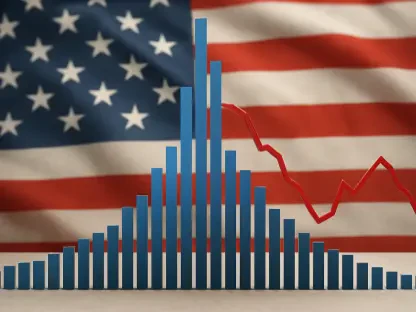The recent U.S. government shutdown, triggered by a failure to pass a stopgap funding bill amid political gridlock between Republicans and Democrats, has sent ripples far beyond the halls of Washington. This impasse has not only furloughed federal workers and shuttered public services but has also cast a shadow over the energy sector, a critical pillar of both national and global economic stability. The absence of key data and economic indicators, coupled with heightened uncertainty, has left energy markets teetering on the edge. Traders and industry stakeholders now face an unprecedented challenge in navigating a landscape where even minor disruptions can lead to significant volatility. This situation raises pressing questions about how such political dysfunction reverberates through oil, gas, and power markets, threatening the delicate balance that underpins price stability and investment decisions.
Data Disruptions in Energy Reporting
Challenges from Suspended EIA Reports
The suspension of vital data from the U.S. Energy Information Administration (EIA) stands as one of the most immediate and severe consequences of the government shutdown. Typically, the EIA releases weekly petroleum and natural gas reports that serve as cornerstones for market transparency and price discovery. With these reports halted, a critical gap has emerged, marking a significant disruption not seen in over a decade. Traders, who rely on this information to make informed decisions, are now forced to turn to less reliable alternatives such as private surveys or data from organizations like the American Petroleum Institute (API). These sources, while useful, lack the comprehensive scope and authority of EIA reports, often leading to fragmented insights. The absence of a universal benchmark means localized issues, such as refinery outages or shipping delays, can disproportionately inflate price swings, injecting a level of volatility into markets that are already under strain from global supply concerns.
Navigating Markets with Fragmented Information
Beyond the immediate loss of EIA data, the broader challenge lies in the patchwork of information that traders must now piece together to assess market conditions. Ship-tracking data and regional reports offer some visibility, but they often vary in accuracy and scope, creating inconsistencies that undermine confidence. Without a centralized source of truth, market participants struggle to gauge supply and demand dynamics with precision, leading to speculative trading behaviors that can exacerbate price fluctuations. This uncertainty is particularly problematic in tight markets like diesel and gasoline, where even small miscalculations can ripple through supply chains. The lack of reliable data not only complicates day-to-day trading but also hinders long-term planning for refineries and energy producers, who depend on stable forecasts to manage inventories and investments. As a result, the shutdown has transformed routine market operations into a high-stakes guessing game, with far-reaching implications for energy stability.
Economic and Market Uncertainty
Impact of Missing Economic Indicators
The government shutdown extends its disruptive reach beyond energy-specific data, halting critical economic reports from agencies like the Bureau of Labor Statistics and the Bureau of Economic Analysis. Key indicators such as employment figures and inflation rates, which provide essential context for assessing energy demand and industrial consumption, are no longer available. This absence leaves oil and natural gas traders without a clear picture of economic health, making it difficult to predict trends in fuel usage or industrial output. Analysts from major financial institutions have estimated that each week of shutdown could shave off a small but measurable fraction of U.S. GDP, translating to a direct reduction in oil demand by thousands of barrels per day. While this may appear minor against the backdrop of millions of barrels consumed daily, the psychological impact on traders amplifies reactions, often leading to tighter margins for refineries and wider price spreads in already volatile markets.
Broader Confidence Erosion in Trading
The erosion of confidence in energy markets represents a deeper, more systemic issue stemming from the shutdown. Without official data and economic signals to anchor decisions, market participants face heightened uncertainty that permeates every level of trading. Expert voices from the industry have emphasized how the loss of standardized information levels the playing field in a negative way, leaving even seasoned traders vulnerable to missteps. Small shocks, which might have been absorbed under normal circumstances, now risk triggering outsized effects due to the lack of reliable benchmarks. This murkier environment also raises financing costs for energy projects and slows the permitting process for new initiatives, as investors hesitate amid unclear economic forecasts. The cumulative effect is a market on edge, where the interplay between political dysfunction and economic vitality becomes painfully evident, forcing stakeholders to brace for potential disruptions with limited tools at their disposal.
Looking Back at Market Resilience
Reflecting on the aftermath of the government shutdown, it became clear that the energy sector faced significant hurdles due to the sudden loss of critical data and economic clarity. The suspension of EIA reports and broader economic indicators had created a void that alternative sources struggled to fill, leaving traders to navigate a volatile landscape with incomplete information. This period underscored the fragility of market stability when political gridlock interferes with essential government functions, amplifying even minor disruptions into major price swings.
Moving forward, the experience highlighted the urgent need for contingency plans to mitigate such risks in the future. Industry leaders and policymakers were prompted to consider mechanisms for maintaining data continuity during shutdowns, such as empowering independent agencies to release interim reports. Additionally, fostering collaboration between public and private sectors to develop more robust alternative data sources emerged as a key takeaway. These steps, if implemented, could help buffer the energy market against similar crises, ensuring that political impasses no longer threaten the foundation of economic stability.









